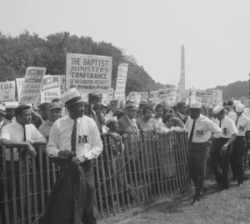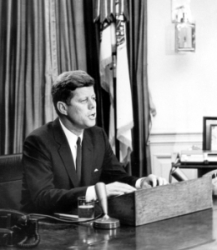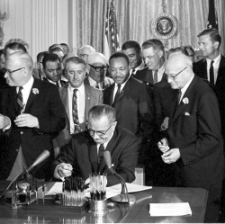The Civil Rights Act of 1964 was the nation’s premier civil rights legislation. The Act outlawed discrimination on the basis of race, color, religion, sex, or national origin, required equal access to public places and employment, and enforced desegregation of schools and the right to vote. It did not end discrimination, but it did open the door to further progres
Many Attempts at Change

Warren K. Leffler, LOC, LC-U9- 10361-23
Each year, from 1945 until 1957, Congress considered and failed to pass a civil rights bill. Congress finally passed limited Civil Rights Acts in 1957 and 1960, but they offered only moderate gains. As a result of the 1957 Act, the United States Commission on Civil Rights was formed to investigate, report on, and make recommendations to the President concerning civil rights issues. Sit-ins, boycotts, Freedom Rides, the founding of organizations such as the Student Nonviolent Coordinating Committee (SNCC) and the Southern Christian Leadership Conference (SCLC), local demands for inclusion in the political process, all were in response to the increase in legislative activity through the 1950s and early 1960s.
The Civil Rights Act is Born; A President is Assasinated

In response to the report of the United States Commission on Civil Rights, President John F. Kennedy proposed, in a nationally televised address, a Civil Rights Act of 1963. A week after his speech, Kennedy submitted a bill to Congress addressing civil rights (H.R. 7152). He urged African American leaders to use caution when demonstrating since new violence might alarm potential supporters. Kennedy met with businessmen, religious leaders, labor officials, and other groups such as CORE and NAACP, while also maneuvering behind the scenes to build bipartisan support and negotiate compromises over controversial topics.
Final Challenges Before Passage

Cecil Stoughton, White House Press Office
The real battle was waiting in the Senate, however, where concerns focused on the bill’s expansion of federal powers and its potential to anger constituents who might retaliate in the voting booth. Opponents launched the longest filibuster in American history, which lasted 57 days and brought the Senate to a virtual standstill.
Senate minority leader Everett Dirksen nurtured the bill through compromise discussions and ended the filibuster. Dirksen’s compromise bill passed the Senate after 83 days of debate that filled 3,000 pages in the Congressional Record. The House moved quickly to approve the Senate bill.
Quickfacts
What is it? A landmark piece of civil rights legislation.
Significance: Outlawed discrimination on the basis of race, sex, religion, color, or national origin.
Date: July 2, 1964
Associated Sites: The United States Capitol, The White House